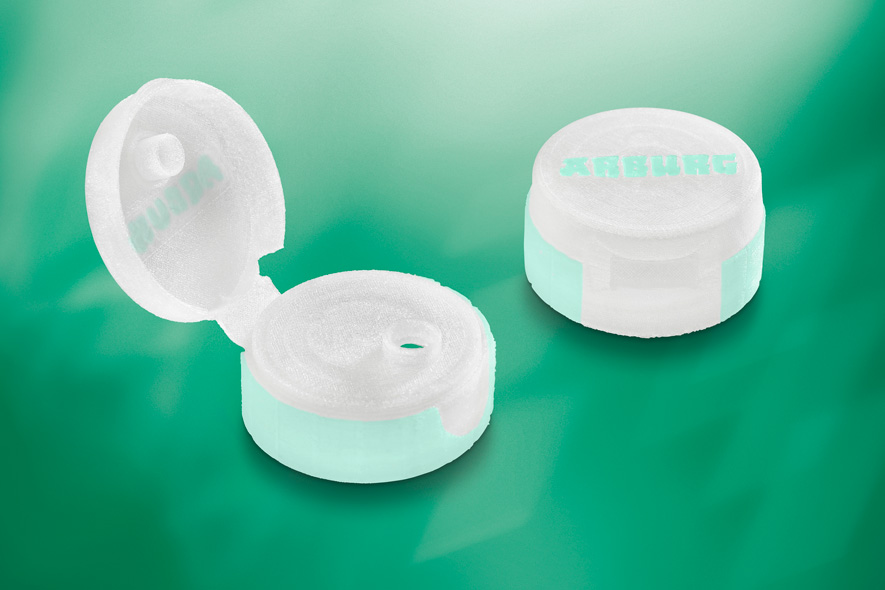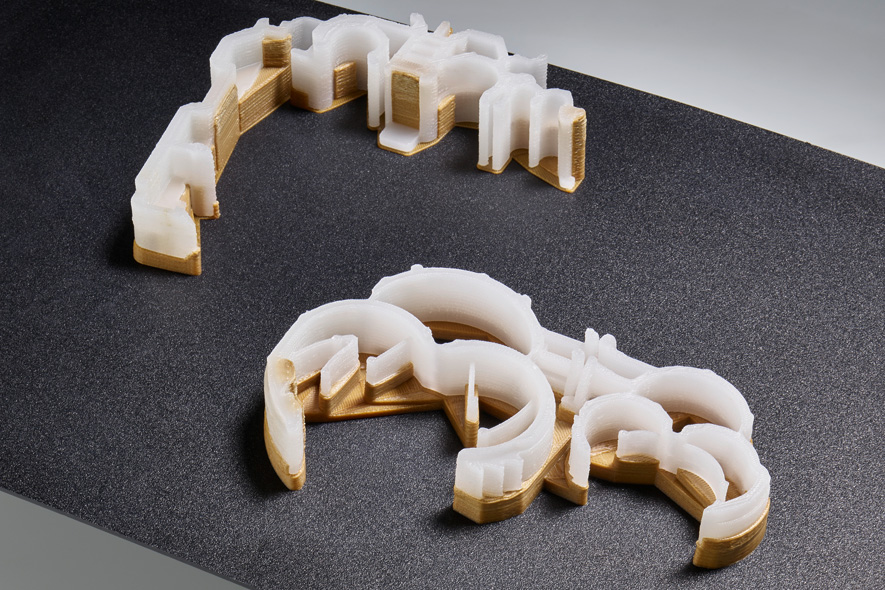
When it comes to demanding AM parts, the Freeformer is in its element. The Arburg Plastic Freeforming (APF) process with the Freeformer is predestined for the processing of semi-crystalline and soft materials as well as a combination of both. Practical examples are living hinges or flip-top-closures that have to be tested thoroughly by creating functional prototypes.
“Our Freeformer in sizes 200-3X and 300-3X process plastic granulates of the kind also used in injection molding. This makes the open system very economical and also enables a big variety of original materials to be used”, explains Lukas Pawelczyk, Head of Freeformer Sales at Arburg headquarters in Lossburg, Germany. “An interesting application field for the APF process are fully functional prototypes of demanding mass products.”

Freeformers in sizes 200-3X and 300-3X process plastic granulates, as also used in injection molding. Image courtesy of Arburg.
Challenging product design
The Freeformer is particularly interesting for users who want to produce and test individually customised parts or functional prototypes made from exactly the same material as in large-scale production of the end product. Living hinges made of PP, which are used for flip-top closures in food packaging, cosmetics and toiletries, for example, are typically designed to flex more than a million cycles without failure and lasting throughout a product‘s lifetime. Polypropylene (PP) is considered an ideal material because it flows well though thin areas and does not stress crack when flexed. The product designs are challenging: The hinge normally allows a part to fold or bend from 1 to 180 degrees. If the plastic is too thin, it may tear. However, if it is too thick, the part may fracture. Therefore a new design needs to be tested to avoid costly mistakes before committing to build an injection mold.
Fully functional PP prototpyes of living hinges
Common testing methods are to create a prototype mold. However to get a part in hand can still take weeks and cost thousands of dollars More companies are turning to 3D printing for a faster, more cost effective way to get a test part. The ability to 3D print original material for the application makes the Freeformer the right tool for fully functional PP prototypes. It allows users to print living hinges without augmenting the original design.

Living hinges, in this case made of PP and TPE, must be capable of bending frequently without breaking. With the APC process it is possible to produce functional prototypes that are almost as stable as a molded parts and can be opened and closed several thousand times. Image courtesy of Arburg.
For a well-known packaging company Arburg was able to use the 3D files for Fhe freeformer with no file augmentation and print ten parts from LyondellBasell Adsyl 5C30F Polypropylene in 35 hours. The parts were delivered to the customer in two days at a significantly lower cost. By speeding up part delivery, the project was green-lighted a week early.
Freeformer produces two component parts
“The production of functional parts made of semi-crystalline PP as well as flexible TPE as a classic hard/soft-combination is a unique and particularly challenging combination in the AM industry”, explains Lukas Pawelczyk. Moreover, the Freeformer 300-3X can process up to three components, thereby enabling the industrial additive manufacturing of complex parts in resilient hard/soft combinations with support structure. At the tct Asia 2021 PP/TPE flip-top closures were produced this way. Prototypes like this with film hinges can be opened and closed several thousand times and can therefore be subjected to full functional testing. Seamlessly combining semi-crystalline PP and soft TPE for products such as functional pharmaceutical components is another unique application.
Solubable support material
For PP and various other materials such as PA and TPU Arburgalso offers the ideal armat support material. One practical benefit is the fact that it can easily be dissolved in a water or alkaline bath without the need for manual work. A Freeformer 200-3X produced e. g. complex cable clips with clip locks made out of standard PP and armat 12. The support material is thermally stable and dissolves six times faster than PVA when placed in warm water. The droplet-based discharge method and the design of the support structures make it also possible to create hollow bodies, complex lightweight structures and component walls that are just a few layers thick.

A Freeformer can produce cable clips with delicate structures and click effect made of standard PP (Moplen) and Armat 12 support material that is water solulable. Image courtesy of Arburg.
Open system makes a wide range of materials possible
The APF process begins – as in injection molding – with melting of the granulate via a heated plasticising cylinder. Next, a stationary high frequency nozzle closure discharges up to 240 droplets per second. The part carrier, which is movable via three axes, can be positioned in the x, y and z directions and enables the precise placement of each individual droplet at the previously calculated position. The discharge rate and layer thickness depend on the nozzle size, frequency and set droplet volume. In order to achieve reproducible additive manufacturing using the open APF process, the plastics used are first qualified in a standardised process and the process settings are predefined. Users can either use the open system to qualify and process their own original materials or access the material database of Arburg. In addition to standard granulates such as ABS, amorphous PA, PC and semi-crystalline PP, this also includes special synthetic materials for special applications such as medical PLLA (Resomer LR 708), FDA-approved TPE (Medalist MD 12130H) or flame-retardant materials approved for the air and space industry based on PEI (Ultem 9085).
Subscribe to Our Email Newsletter
Stay up-to-date on all the latest news from the 3D printing industry and receive information and offers from third party vendors.
You May Also Like
Precision at the Microscale: UK Researchers Advance Medical Devices with BMF’s 3D Printing Tech
University of Nottingham researchers are using Boston Micro Fabrication‘s (BMF) 3D printing technology to develop medical devices that improve compatibility with human tissue. Funded by a UK grant, this project...
3D Printing Webinar and Event Roundup: April 21, 2024
It’s another busy week of webinars and events, starting with Hannover Messe in Germany and continuing with Metalcasting Congress, Chinaplas, TechBlick’s Innovation Festival, and more. Stratasys continues its advanced training...
3D Printing Webinar and Event Roundup: March 17, 2024
It’s another busy week of webinars and events, including SALMED 2024 and AM Forum in Berlin. Stratasys continues its in-person training and is offering two webinars, ASTM is holding a...
3D Printed Micro Antenna is 15% Smaller and 6X Lighter
Horizon Microtechnologies has achieved success in creating a high-frequency D-Band horn antenna through micro 3D printing. However, this achievement did not rely solely on 3D printing; it involved a combination...





























